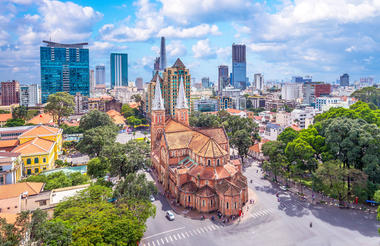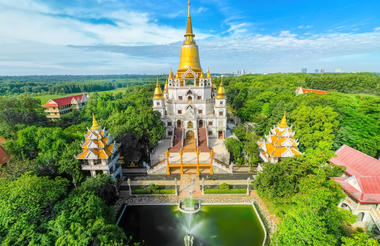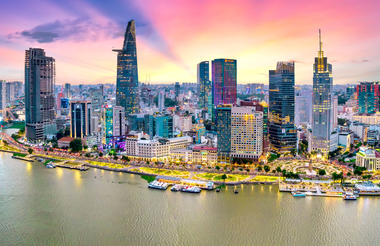The perfect complement to the more serene Hanoi, Ho Chi Minh City (formerly Saigon) has a pulsating energy that is impossible to resist. Attractions include the bustling Ben Thanh Market, where vendors sell everything from food, sweets and spices to tobacco, souvenirs and clothing - including custom-made suits, and Nha Hang Ngon, where you can taste traditional street food served up from food stalls in a leafy garden. Other notable sites and experiences include the Notre-Dame Basilica, the Jade Emperor Pagoda for its statues and woodcarvings, the War Remnants Museum, and the Khanh Van Nam Vien Pagoda, said to be the only pure Taoist temple in Vietnam.



Nha Trang is Vietnam’s most famous seaside resort-town, set apart by its lively, urban atmosphere, its dynamic nightlife, as well as some of the country’s best beaches and dive sites. A glorious 6 km stretch of golden sand is lapped by azure waters on one side and lined with cafés, restaurants, parks and some rather unique public sculptures on the other. While on the surface it may appear to be yet another seaside party town, the city has many hidden charms waiting to be discovered. Must see attractions include: the majestic temple, Po Nagar; Dam Market, home to some of the city’s best French-colonial architecture and crumbling 19th-century Chinese houses; and the world’s longest cross-sea cable-car ride which transports visitors to nearby Hon Tre (Bamboo Island).



Hoi An, on Vietnam’s central coast, is enchanting. This once-bustling port town offers a colourful blend of French, Chinese and Japanese-influenced architecture, canals, bridges and temples, and the lack of noisy traffic (no cars are allowed on the main streets) means you can discover the town in relative peace and quiet. Its waterfront area is alive with boutique hotels, eateries, tailor shops, and art and craft shops. If you have time, try to fit in a visit to the ruins of My Son Sanctuary, an ancient Hindu tower temple complex, get custom-made clothing created by a local tailor and pick up one of the many beautiful locally-made Vietnamese lanterns.



Beguiling and beautiful, the former capital of Vietnam is still revered as a cultural and religious centre, and achieved UNESCO World Heritage status in 1993. The city owes its charm in part to its setting on the Perfume River, but more significantly, to its many ancient temples and palaces – all vestiges of the last remaining Vietnamese dynasty, the Nguyen dynasty. The 19th century Hue Citadel, otherwise known as The Imperial City, should be high on your ‘to-see' list (you will need a day to get through the entire complex); while scattered along the riverbank are myriad more shrines and stupa, including the Thien Mu Pagoda with its octagonal tower. Bathe in a number of mineral hot springs, take a boat trip along the river, or take a ‘food tour’ of the superb eateries in town.



With its wide boulevards, ancient pagodas and tree-lined lakes, Vietnam’s capital is also the country’s most atmospheric and beguiling city. There is an energy and charm here arising from the genteel mix of French colonialism and Asian grace and tradition. Enjoy a showcase of synchronised t’ai chi at Hoan Kiem Lake; stroll around the lively Old Quarter with its narrow streets with traders and hoards of scooters weaving in and out, and don’t miss the chance to see a water puppetry show at the Thang Long Puppet Theatre. Other places to visit include the Imperial Citadel of Thang Long, the Perfume Pagoda temple complex and the Hanoi Opera House in the heart of the French Quarter.



As previously described








